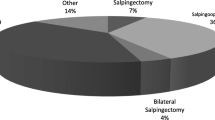Abstract
Background
The laparoscopic management of tubo-ovarian abscesses (TOA) was evaluated. The study sought to answer the following question: Does operative laparoscopy with only incision of the abscess cavity and lavage (organpreserving treatment) improve intraoperative and postoperative safety and long-term prospects of fertility as compared with laparoscopic salpingectomy or salpingo-oophorectomy (ablative treatment)?
Methods
A retrospective chart review of 60 patients with TOA undergoing laparoscopic treatment in combination with broad-spectrum antibiotics from 1994 to 1998 was performed. Patients not wishing to have children underwent salpingectomy or salpingo-oophorectomy, whereas patients wishing to remain fertile were treated by means of an organpreserving procedure. To investigate the operative and reproductive outcome, patients were interviewed by telephone.
Results
Of 60 women with TOA, 25 were treated laparoscopically, preserving the internal genital organs, and 35 underwent ablative treatment. Apart from one postoperative readmission because of lower pelvic pain in the organpreserving group, there were no operative complications or serious systemic sequelae. In contrast, there was a significantly higher incidence of intraoperative and postoperative complications when ablative treatment was performed: one intestinal perforation requiring subsequent laparotomy, four serosal lesions, two lesions of the greater omentum, two lacerated collaterals of the internal iliac artery, one postoperative fever higher than 38°C for 2 days, two bowel obstructions, one thrombosis of the upper leg, and one thrombosis of the lower leg. There were no significant differences between the two patient groups in body mass index, duration of pelvic pain, laboratory findings at admission, ultrasonic assessment of abscess size, and the extent of the abscess at laparoscopy.
Conclusions
When laparoscopic treatment of TOA is performed, organ-preserving treatment should be chosen irrespective of the patient’s age or desire to have children because of the risk of complications.
Similar content being viewed by others
References
DeWilde R, Hesseling M (1995) Tube-preserving diagnostic operative laparoscopy in pyosalpinx. Gynaecol Endosc 4: 105–108
Grazia Porpora M., Gomel V (1997) The role of laparoscopy in the management of pelvic pain in women of reproductive age. Fertil Steril 68: 765–779
Henry-Suchet J, Soler A., Loffredo V (1984) Laparoscopic treatment to tubo-ovarian abscesses. J Reprod Med 8: 579
Johns DA (1994) Laparoscopic treatment of tubo-ovarian abscess. In: Sutton C, Diamand M (eds) Endoscopic surgery of gynaecologists, third printing. W. B. Saunders, London, Philadelphia, Toronto, Sydney, Tokyo, pp 154–158
Kaplan AL, Jacobs WM, Ehresman JB (1967) Aggressive management of pelvic abscess. Am J Obstet Gynec 98: 482–487
Kolmorgen K, Seidenschnur G, Dobreff U (1988) Diagnosis and surgical therapy of suppurative inflammations of the adnexa. Zentralbl Gynakol 110: 423–428
Landers DV, Sweet RL (1985) Current trends in the diagnosis and treatment of tuboovarian abscess. Am J Obstet Gynecol 151: 1098–1110
Mecke H, Semm K, Freys I, Gent H (1991) Pelvic abscesses: pelviscopy or laparotomy. Gynecol Obstet Invest 31: 231–234
Nezhat CR (1995) Operative gynecologic laparoscopy: principles and technique. 1st ed. McGraw-Hill New York, St Louis, San Francisco, London, Milan, Sydney, Toronto, Tokyo, pp 185–201
Reich H, McGlynn F (1987) Laparoscopic treatment of tubo-ovarian and pelvic abscesses. J Reprod Med 32: 747–752
Rivlin ME, Hunt JA (1977) Ruptured tuboovarian abscess: is hysterectomy necessary? Obstet Gynecol 50: 518–522
Rizk P (1995) Operative laparoscopy in the management of tuboovarian abscess. J Am Assoc Gynecol Laparosc 2(4, Suppl): 46
Author information
Authors and Affiliations
Additional information
Online publication: 29 August 2000
Online publication: 9 August 2000
Rights and permissions
About this article
Cite this article
Buchweitz, O., Malik, E., Kressin, P. et al. Laparoscopic management of tubo-ovarian abscesses. Surg Endosc 14, 948–950 (2000). https://doi.org/10.1007/s004640000249
Received:
Accepted:
Published:
Issue Date:
DOI: https://doi.org/10.1007/s004640000249




